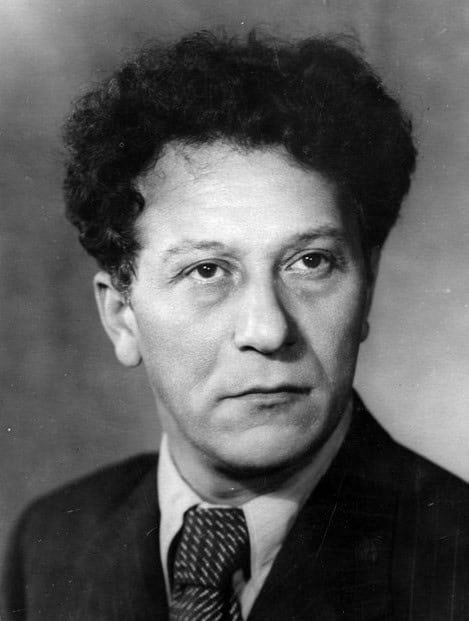Death of Abraham Alikhanian (December 8, 1970)

Abraham Alikhanian is widely recognized as one of the leading Soviet physicists who specialized in particle and nuclear physics. He also joined the atomic bomb project and led the development of heavy water reactors.
Alikhanian (Abram Alikhanov in Russian) was born on March 4, 1904, in Elizavetpol, the historical Armenian city of Gandzak (today Ganja, in Azerbaijan). His father was a railroad engineer in the Transcaucasus Railway. His younger brother Artem (1908-1978) was also a noted physicist. They had two sisters. His family lived in Alexandropol (today Gyumri) in 1912–13, where Alikhanian attended a commercial college. Then they moved to Tiflis (today Tbilisi), where they stayed until 1918, and returned to Alexandropol until the Turkish-Armenian war of 1920. After another move to Tiflis, he graduated from a commercial college in 1921. Although he enrolled in the Polytechnic Institute of Tiflis, he did not study for the most part to help support himself and his family.
In 1923 Alikhanian moved to Leningrad (now St. Petersburg) and enrolled in the chemistry department of the Polytechnic Institute, transferring to the department of physics and mechanics a year later. In 1927 he began working part-time at the Physical-Technical Institute in Leningrad as a researcher focusing on X-rays and solid-state physics and became a full-time researcher after graduating and publishing his first paper in 1929. He published his first paper in 1929. He began a long-time collaboration with his younger brother Artem and Lev Artsimovich in 1930.
Alikhanian switched to nuclear physics in 1933, following the discovery of the neutron and the positron the year before. He was appointed head of the positron laboratory at the Department of Solid-State Physics at the Physical-Technical Institute. In 1939, he was elected corresponding member of the Soviet Academy of Sciences and in 1943, full member. In the same year, he was elected full member of the newly created Armenian Academy of Sciences.
 Abraham and Artem Alikhanian established the Yerevan Physics Institute in 1943 as a branch of the Yerevan State University. After returning to Russia, Abraham Alikhanian worked at the Institute for Physical Problems in Moscow from 1944 to 1946. Between 1947 and 1951, he headed the Department of Structure of Matter at the Faculty of Physics and Technology of Moscow State University. He helped organize the Nuclear Physics Division of the Soviet Academy of Sciences.
Abraham and Artem Alikhanian established the Yerevan Physics Institute in 1943 as a branch of the Yerevan State University. After returning to Russia, Abraham Alikhanian worked at the Institute for Physical Problems in Moscow from 1944 to 1946. Between 1947 and 1951, he headed the Department of Structure of Matter at the Faculty of Physics and Technology of Moscow State University. He helped organize the Nuclear Physics Division of the Soviet Academy of Sciences.
Alikhanian was involved in the Soviet atomic bomb project in 1942. He led the research on the construction of a heavy-water reactor.
Laboratory no. 3 of the Soviet Academy of Sciences, headed by Alikhanov, was established in Moscow in 1945. It was renamed Heat-Engineering Laboratory in 1949 and Institute for Theoretical and Experimental Physics (ITEP) in 1958. The institute was initially focused on the construction of the first nuclear reactor based on heavy water in the USSR, which operated between 1949 and 1987. The reactor was not invented for nuclear power generation, but for experiments that would advance the design and construction of other reactors.
Alikhanian also led the project to design the first industrial heavy-water reactor in the Soviet Union. After its completion, by 1952, the main direction of his institute became the construction of a high-energy accelerator, which was commissioned in 1961. The accelerator made it possible to conduct research on elementary particle physics on a broader scale and became the prototype for the largest proton accelerator in the world at the time, which was commissioned in 1967.
 Alikhanian never joined the Communist Party and, according to his colleague Boris L. Joffe, he was “fairly outspoken” and “did not like the Soviet regime.” He directed the institute until his retirement in 1968. He married twice and had four children. He suffered a stroke in 1964 and passed away in Moscow on December 8, 1970, at the age of 66. He was buried at the Novodevichy Cemetery.
Alikhanian never joined the Communist Party and, according to his colleague Boris L. Joffe, he was “fairly outspoken” and “did not like the Soviet regime.” He directed the institute until his retirement in 1968. He married twice and had four children. He suffered a stroke in 1964 and passed away in Moscow on December 8, 1970, at the age of 66. He was buried at the Novodevichy Cemetery.
ITEP was named after Abraham Alikhanian in 2004. A street in Yerevan is named for the Alikhanian brothers, while a street in Moscow was renamed Academician Alikhanov Street in 2018.
